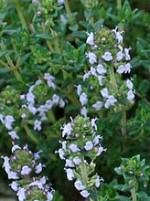
Also called English thyme, this well branched aromatic evergreen shrub is native to the western Mediterranean region to southern Italy. It is a member of the mint family, Lamiaceae, that also includes basil, rosemary, and beebalm. Plants grow 3-12” tall and have a woody base and ¼” –1/2” long, lanceolate, gray-green leaves with margins rolled under. The ¼” tubular lilac to pink flowers are carried in whorls in small terminal clusters from late spring to early summer. Thyme works well with almost any food and is considered one of the fines herbes of French cooking. Harvest before it blooms and use it in stews, soups, bread, salads, make herbal butter, or use a sprig as a garnish. It will be an asset in or on almost any dish you serve up. This kind of thyme is easy to grow and doesn’t need pampering or a lot of attention. It is even said to repel cabbageworms and whiteflies as well as enhance the growth of tomatoes, potatoes and eggplant. Bees love the flowers so you might want to consider setting up a beehive nearby.
Type: Perennial evergreen shrub
Bloom: Small tubular lilac to pink flowers are borne in terminal clusters in early summer.
Foliage: Small, oblong to lanceolate, opposite leaves with edges rolled under.
Size: 3-12” H x 12+” W.
Light: Full sun to partial shade.
Soil: Average, light, dry, well-well drained.
Fertilizer: Apply an organic, nitrogen rich fertilizer monthly for abundant growth.
Hardiness: Zones 5-9.
Care: Cut back to 3” in spring to encourage new growth; shear after blooming; replace when bushes get woody (every 2-3 years).
Pests and Diseases: Susceptible to fungal diseases and root rot if grown in overly moist soil; can be infected by spider mites.
Propagation: Layering, cuttings in spring, division in spring or fall; seed.
Photo Credit: Wikipedia
